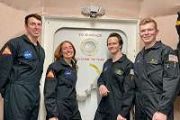
Copernical Team
Did a cosmic impact destroy an ancient city in the Jordan Valley
 In the Middle Bronze Age (about 3600 years ago or roughly 1650 BCE), the city of Tall el-Hammam was ascendant. Located on high ground in the southern Jordan Valley, northeast of the Dead Sea, the settlement in its time had become the largest continuously occupied Bronze Age city in the southern Levant, having hosted early civilization for a few thousand years. At that time, it was 10 times large
In the Middle Bronze Age (about 3600 years ago or roughly 1650 BCE), the city of Tall el-Hammam was ascendant. Located on high ground in the southern Jordan Valley, northeast of the Dead Sea, the settlement in its time had become the largest continuously occupied Bronze Age city in the southern Levant, having hosted early civilization for a few thousand years. At that time, it was 10 times large NASA launches new mission to monitor Earth's landscapes
 Landsat 9, a NASA satellite built to monitor the Earth's land surface, successfully launched at 2:12 p.m. EDT Monday from Vandenberg Space Force Base in California.
A joint mission with the U.S. Geological Survey (USGS), Landsat 9 lifted off on a United Launch Alliance Atlas V rocket from Vandenberg's Space Launch Complex 3E. Norway's Svalbard satellite-monitoring ground station acquired s
Landsat 9, a NASA satellite built to monitor the Earth's land surface, successfully launched at 2:12 p.m. EDT Monday from Vandenberg Space Force Base in California.
A joint mission with the U.S. Geological Survey (USGS), Landsat 9 lifted off on a United Launch Alliance Atlas V rocket from Vandenberg's Space Launch Complex 3E. Norway's Svalbard satellite-monitoring ground station acquired s DARPA'S Hypersonic Air-breathing Weapon Concept achieves successful flight
 DARPA, in partnership with the U.S. Air Force, completed a free flight test of its Hypersonic Air-breathing Weapon Concept (HAWC) last week. The missile, built by Raytheon Technologies, was released from an aircraft seconds before its Northrop Grumman scramjet (supersonic combustion ramjet) engine kicked on. The engine compressed incoming air mixed with its hydrocarbon fuel and began igniting th
DARPA, in partnership with the U.S. Air Force, completed a free flight test of its Hypersonic Air-breathing Weapon Concept (HAWC) last week. The missile, built by Raytheon Technologies, was released from an aircraft seconds before its Northrop Grumman scramjet (supersonic combustion ramjet) engine kicked on. The engine compressed incoming air mixed with its hydrocarbon fuel and began igniting th Recreating "real food meals" as small cubes that taste like candy
 According to "The State of Food Security and Nutrition in the World," approximately 811 million people around the world were undernourished in 2020. Although proper nutrition is the cornerstone of good health, it is something many people still do not have access to. To help overcome this global challenge, MealCubes recreate the world's healthiest meals in the convenience of a few tasty candies t
According to "The State of Food Security and Nutrition in the World," approximately 811 million people around the world were undernourished in 2020. Although proper nutrition is the cornerstone of good health, it is something many people still do not have access to. To help overcome this global challenge, MealCubes recreate the world's healthiest meals in the convenience of a few tasty candies t Space Force upskilling Guardians with process mapping and automation
 The Space Force held its first Robotic Process Automation Workshop to explore how to effectively leverage bots to execute repetitive processes, as part of efforts to modernize the world-class fighting force at the speed of relevance. Permanent staff from the U.S. Space Force Space Operations Command, Headquarters U.S. Space Force, Air Force Personnel Center, and Air Force Reserve Personnel Cente
The Space Force held its first Robotic Process Automation Workshop to explore how to effectively leverage bots to execute repetitive processes, as part of efforts to modernize the world-class fighting force at the speed of relevance. Permanent staff from the U.S. Space Force Space Operations Command, Headquarters U.S. Space Force, Air Force Personnel Center, and Air Force Reserve Personnel Cente Virgin Galactic cleared to launch after US closes safety probe
 Virgin Galactic said Wednesday it had been cleared for spaceflight after the Federal Aviation Agency (FAA) concluded a probe into a safety "mishap" related to its high-profile mission in July that featured company founder Richard Branson.
The FAA told the company it had accepted its proposed corrective actions related to the flight, which saw the SpaceShipTwo vehicle drop below its assigned
Virgin Galactic said Wednesday it had been cleared for spaceflight after the Federal Aviation Agency (FAA) concluded a probe into a safety "mishap" related to its high-profile mission in July that featured company founder Richard Branson.
The FAA told the company it had accepted its proposed corrective actions related to the flight, which saw the SpaceShipTwo vehicle drop below its assigned ESA Open Day on our Web TV

ESA Web TV is offering live coverage of events across ESA establishments during Sunday afternoon’s ESA Open Day.
Cosmic kit
 Image:
ESA astronaut Matthias Maurer wearing the SpaceX spacesuit
Image:
ESA astronaut Matthias Maurer wearing the SpaceX spacesuit Aerosols released from Australian bushfires triggers algal blooms

Australia’s deadly bushfires in the 2019-2020 season generated 700 million tonnes of carbon dioxide in the atmosphere – triggering vast algal blooms in the Southern Ocean. Using satellite data, two new studies published in Nature prove how satellites can illuminate the complicated ways in which Earth is responding to climate change in an era of worsening wildfires.
Virgin Galactic says FAA has cleared it for further flights
































